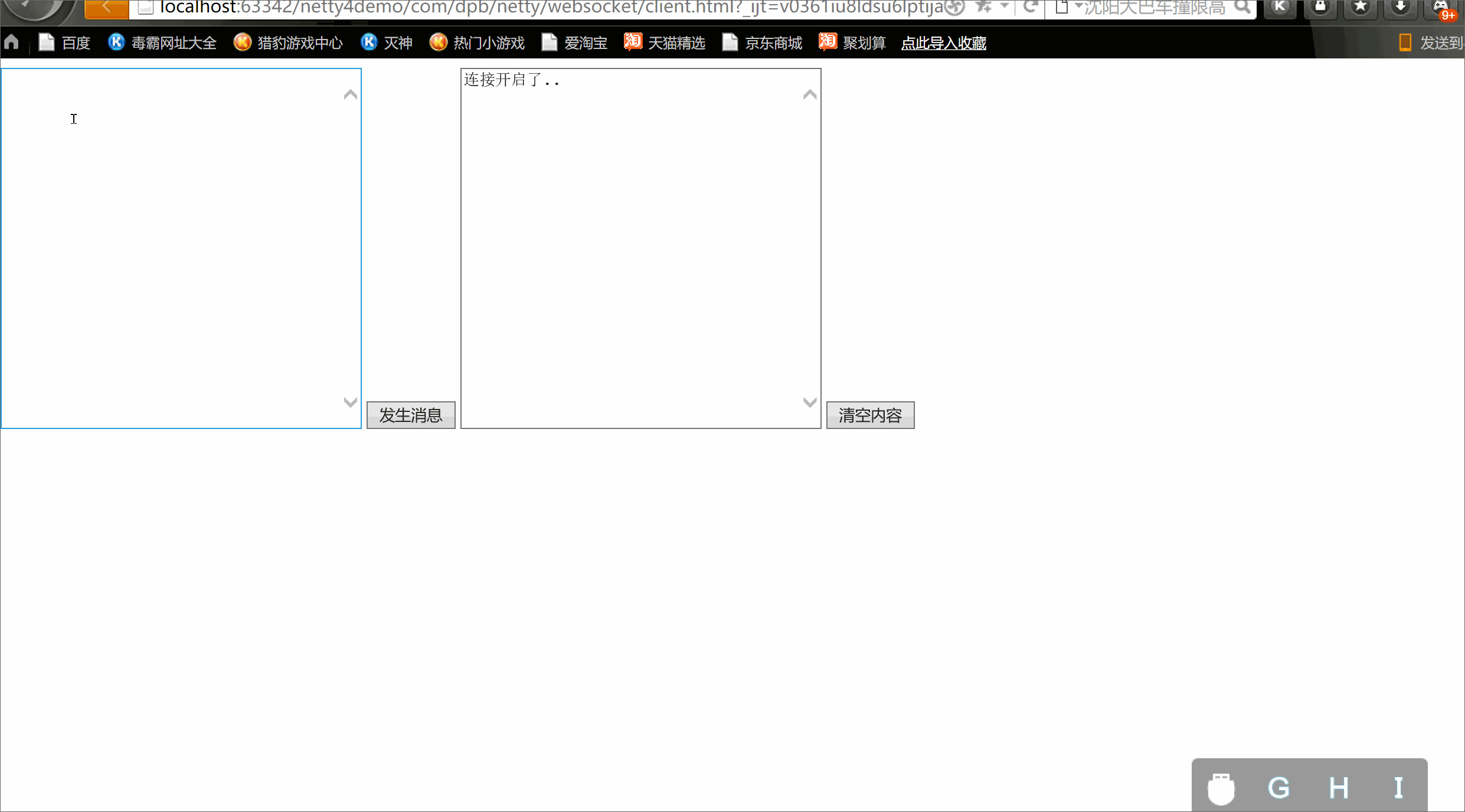本文我们来实现一个基于WebSocket协议的案例。
WebSocket案例
1.需求分析
Http协议是无状态的, 浏览器和服务器间的请求响应一次,下一次会重新创建连接.所有在有些情况下并不是太适用。这时websocket就是我们的一种实现方案,具体的websocket的内容网上很多,自行查阅哦,本文主要是介绍基于netty如何实现websocket通信。
要求:
- 实现基于webSocket的长连接的全双工的交互
- 改变Http协议多次请求的约束,实现长连接了, 服务器可以发送消息给浏览器
- 客户端浏览器和服务器端会相互感知,比如服务器关闭了,浏览器会感知,同样浏览器关闭了,服务器会感知
2.案例代码实现
2.1 服务端处理器
服务器处理器中我们仅仅需要处理请求和客户端连接和端口的情况,具体如下:
package com.dpb.netty.websocket;
import io.netty.channel.ChannelHandlerContext;
import io.netty.channel.SimpleChannelInboundHandler;
import io.netty.handler.codec.http.websocketx.TextWebSocketFrame;
import java.time.LocalDateTime;
/**
* @program: netty4demo
* @description: 处理器
* @author: 波波烤鸭
* @create: 2019-12-30 22:39
*/
public class SocketServerHandler extends SimpleChannelInboundHandler<TextWebSocketFrame> {
protected void channelRead0(ChannelHandlerContext channelHandlerContext, TextWebSocketFrame textWebSocketFrame) throws Exception {
// 打印接收到的消息
System.out.println("服务端接受到的消息:" + textWebSocketFrame.text());
// 返回消息给客户端
channelHandlerContext.writeAndFlush(new TextWebSocketFrame("服务器时间: " + LocalDateTime.now() + " : " + textWebSocketFrame.text()));
}
/**
* 客户端连接的时候触发
* @param ctx
* @throws Exception
*/
public void handlerAdded(ChannelHandlerContext ctx) throws Exception {
// LongText() 唯一的 ShortText() 不唯一
System.out.println("handlerAdded:" + ctx.channel().id().asLongText());
System.out.println("handlerAdded:" + ctx.channel().id().asShortText());
}
/**
* 客户端断开连接的时候触发
* @param ctx
* @throws Exception
*/
public void handlerRemoved(ChannelHandlerContext ctx) throws Exception {
System.out.println("handlerRemoved:" + ctx.channel().id().asLongText());
}
public void exceptionCaught(ChannelHandlerContext ctx, Throwable cause) throws Exception {
System.out.println("异常发生了...");
ctx.close();
}
}
2.2 服务端
服务端代码在原有的基础上需要转换相关的协议,具体如下:
package com.dpb.netty.websocket;
import io.netty.bootstrap.ServerBootstrap;
import io.netty.channel.*;
import io.netty.channel.nio.NioEventLoopGroup;
import io.netty.channel.socket.ServerSocketChannel;
import io.netty.channel.socket.SocketChannel;
import io.netty.channel.socket.nio.NioServerSocketChannel;
import io.netty.handler.codec.http.HttpObjectAggregator;
import io.netty.handler.codec.http.HttpServerCodec;
import io.netty.handler.codec.http.websocketx.WebSocketServerProtocolHandler;
import io.netty.handler.logging.LogLevel;
import io.netty.handler.logging.LoggingHandler;
import io.netty.handler.stream.ChunkedWriteHandler;
import java.net.ServerSocket;
/**
* @program: netty4demo
* @description: 基于WebSocket协议的服务端
* @author: 波波烤鸭
* @create: 2019-12-30 22:31
*/
public class SocketServerDemo {
public static void main(String[] args) throws Exception {
// 1.创建对应的EventLoopGroup对象
EventLoopGroup bossGroup = new NioEventLoopGroup(1);
EventLoopGroup workGroup = new NioEventLoopGroup();
ServerBootstrap bootstrap = new ServerBootstrap();
try{
bootstrap.group(bossGroup,workGroup)
.channel(NioServerSocketChannel.class)
.handler(new LoggingHandler(LogLevel.INFO))
.childHandler(new ChannelInitializer<SocketChannel>() {
protected void initChannel(SocketChannel socketChannel) throws Exception {
// websocket 相关的配置
ChannelPipeline pipeline = socketChannel.pipeline();
//因为基于http协议,使用http的编码和解码器
pipeline.addLast(new HttpServerCodec());
//是以块方式写,添加ChunkedWriteHandler处理器
pipeline.addLast(new ChunkedWriteHandler());
/*
说明
1. http数据在传输过程中是分段, HttpObjectAggregator ,就是可以将多个段聚合
2. 这就就是为什么,当浏览器发送大量数据时,就会发出多次http请求
*/
pipeline.addLast(new HttpObjectAggregator(8192));
/*
说明
1. 对应websocket ,它的数据是以 帧(frame) 形式传递
2. 可以看到WebSocketFrame 下面有六个子类
3. 浏览器请求时 ws://localhost:8888/hello 表示请求的uri
4. WebSocketServerProtocolHandler 核心功能是将 http协议升级为 ws协议 , 保持长连接
5. 是通过一个 状态码 101
*/
pipeline.addLast(new WebSocketServerProtocolHandler("/hello"));
// 自定义handler,处理业务逻辑
pipeline.addLast(new SocketServerHandler());
}
});
System.out.println("服务启动了....");
ChannelFuture future = bootstrap.bind(8888).sync();
future.channel().closeFuture().sync();
}finally {
bossGroup.shutdownGracefully();
workGroup.shutdownGracefully();
}
}
}
2.3 客户端实现
在客户端中我们就简单的实现一个HTML页面,在其中发送websocket协议相关的请求,然后接受相关的消息,如下,注意注释
<html lang="en">
<head>
<meta charset="UTF-8">
<title>websocket案例测试</title>
</head>
<body>
<script>
var socket;
//判断当前浏览器是否支持websocket
if(window.WebSocket) {
//go on
socket = new WebSocket("ws://localhost:8888/hello");
//相当于channelReado, ev 收到服务器端回送的消息
socket.onmessage = function (ev) {
var rt = document.getElementById("responseText");
rt.value = rt.value + "\n" + ev.data;
}
//相当于连接开启(感知到连接开启)
socket.onopen = function (ev) {
var rt = document.getElementById("responseText");
rt.value = "连接开启了.."
}
//相当于连接关闭(感知到连接关闭)
socket.onclose = function (ev) {
var rt = document.getElementById("responseText");
rt.value = rt.value + "\n" + "连接关闭了.."
}
} else {
alert("当前浏览器不支持websocket")
}
//发送消息到服务器
function send(message) {
if(!window.socket) { //先判断socket是否创建好
return;
}
if(socket.readyState == WebSocket.OPEN) {
//通过socket 发送消息
socket.send(message)
} else {
alert("连接没有开启");
}
}
</script>
<form onsubmit="return false">
<textarea name="message" style="height: 300px; width: 300px"></textarea>
<input type="button" value="发生消息" onclick="send(this.form.message.value)">
<textarea id="responseText" style="height: 300px; width: 300px"></textarea>
<input type="button" value="清空内容" onclick="document.getElementById('responseText').value=''">
</form>
</body>
</html>
3.测试分析
分别运行服务器和客户端,访问测试,如下:

运行效果:
同时在第一次运行的时候打开调试环境:

好了,本文我们就介绍到此,感兴趣的可以自己运行下
欢迎关注点赞O(∩_∩)O哈哈~



















